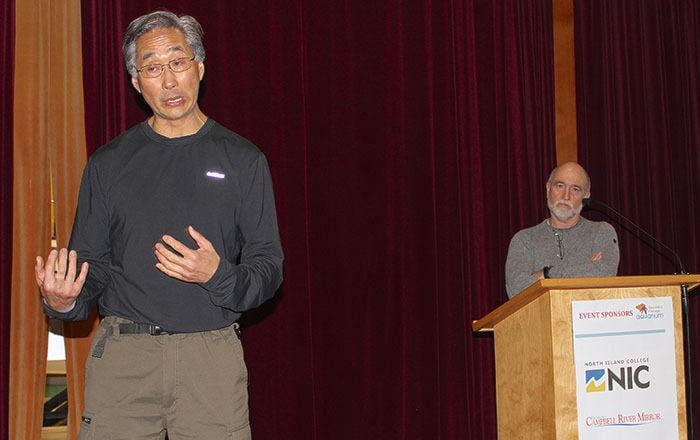With climate change as its new customer, the Salish Sea Restaurant has come up with a second and possibly third or fourth seating for its annual spring buffet.
And Fisheries and Oceans Canada is hoping to take advantage of that menu item to increase survival rates of chinook and coho salmon.
That was one of the messages Mel Sheng, retired Section Head of Salmon Enhancement Programs Operations for Fisheries and Oceans Canada, told a crowd of people at the Discovery Passage Aquarium speaker’s event at the Maritime Heritage Centre March 16.
The public event was sponsored by North Island College and the Campbell River Mirror.
Sheng said new data suggests the annual algal bloom in the Salish Sea (Georgia Strait) isn’t a one-off occurrence. The bloom is vital to the survival of out-migrating salmon from East Vancouver Island, particularly for Campbell and Quinsam River fish. Sheng said satellite technology shows not one, but two or more peaks for the algal bloom.
“Algal blooms become feeding sources for larger creatures in the ecosystem and those creature become a vital food source for young salmon,” said Sheng. “So we’ve become pretty sophisticated with the satellite imagery looking at wave lengths bouncing back off the ocean measuring chlorophyll in the blooms. So we can actually track algal growth in the strait using satellites. It gives us a really good idea how these blooms are changing over time.
“We may be seeing more than one peak, we always thought there was one major peak, usually in the spring time, but because of climate change, we may be seeing some later peaks as well.”
And the Quinsam Hatchery, with funding from the Pacific Salmon Foundation, is ready to send hungry customers to the new eatery.
Former hatchery manager Laurent Frisson confirmed the new clientele is ready and waiting.
He said 100,000 chinook and 20,000 coho are being held back for a later release to time it with the new information.
“It’s twofold, we’re hoping to take advantage of a second plankton bloom, so instead of overwhelming the available food source in the first bloom, we release a different group a little later and with a little bigger size,” he said. “Hopefully, they can take advantage of it and impact less on the ones that are migrating in a typical spring time.”
Sheng said reducing the number of coho and chinook released into the system may have actually helped returns. He said available food sources may also have been better utilized by fewer fish feeding on them.
“We’ve been releasing 6.5 to 7.5 million coho smolts in the strait of Georgia for the last 15 to 20 years,” he said. “But in the last six or seven years we’ve reduced that to four to five million.
“In the last five-to-six years, returns have actually been coming up and seem to be coincidental to when we started reducing our smolt production. We saw an almost corresponding increase in adult returns and survival rate, and that’s been encouraging. Our data shows that, but there’s no scientific link.”
And how has climate change impacted our local waters?
“One of the key things that’s causing our declines is climate change,” he said. “We know for sure that since 1972 to present time, we’ve seen an increase in ocean temperature of one degree.”
Frisson said a normal release of chinook and coho would occur in late May, but the new strategy will have the PSF-funded batch released around early July.
